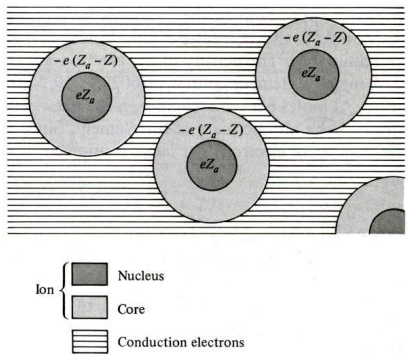Lecture 2
Today
Hartree-Fock approximation
Density functional theory; Kohn-Sham equations
Density response and screening
Reading: GY 15.1 -- 15.3.
1. The Hartree-Fock approximation
General many-electron Hamiltonian
Determinantal wavefunction
The Hartree-Fock approximation can be formulated as a variational problem in the single-determinant Hilbert space
The Hartree-Fock Lagrangian (拉氏量)
Then
yields the Hartree-Fock equations
Koopman's theorem: Let
Single-hole excitation energy then is approximately
Likewise for an unoccupied state, the single-particle excitation energy is approximately

2. H-F approximation for the electron gas
Jellium model. A real crystal is complicated, with nuclei, core (inner shell) electrons and valence (outer shell) electrons. In the jellium model, retain only the valence electrons. The charge of ionic cores (离子实) is smeared into a neutralizing positive background without dynamics.

In this case, the Hartree potential gets cancelled out. Because of the translational invariance,
ensuring planewave solutions. Then
where

Let's evaluate the self energy, which is the matrix element
Finally, we have at the H-F level
where
Note that on the Fermi surface
There is a Fermi surface, but the density of states at the Fermi level is zero!
The electron gas is incompressible within the H-F approximation.
What is missing? Screening, to be explained later.
3. Density functional theory 密度泛函理论
Density functional theory (DFT) is an exact many-body theory, based on two theorems of Hohenberg and Kohn.
With various local approximations, DFT offers a very powerful mean-field theory, using the Kohn-Sham equations
Hohenberg-Kohn theorems: density, instead of wavefunctions, as the key variable
Theorem 1: The g.s. of a many-electron system is a functional of density.
Theorem 2: The energy as a functional of the density is minimized by the g.s. density.
A many-electron system in an external potential coupling to density
Proof of theorem 1 (by redutio ad absurdum 反证法 ). Let
Then, by the Rayleigh-Ritz principle
the inequality strictly holds. Similarly
Adding the inequalities
This cannot be true. Hence the supposition that two distinct g.s. have the same densities cannot be true.
Schr
DFT:

Proof of theorem 2. From
For
The last inequality follows from the Rayleigh-Ritz principle.
v-representability vs N-representability. In the above, we assume
4. Kohn-Sham equations
DFT as presented above is exact, elegant and useless.
Kohn and Sham proposed a set of equations to allow computation like the H-F approximation, called the Kohn-Sham equations.
The non-interacting v-representability. Suppose there is a fictitious (虚构的) non-interacting system
Then from the Hohenberg-Kohn theorem,
where
Kohn and Sham: for any interacting system, there exists a
For the interacting system
where the exchange-correlation energy functional (交换关联泛函) is defined as
From the Hohenberg-Kohn theorem:
leading to the Kohn-Sham equations
where the key novelty is exchange-correlation potential (交换关联势)
Kohn-Sham equations require self-consistent field solution like the H-F equations.
But the universal xc functional is unknown. To make this work, need approximations.
local-density approximation
where
Fixed-point iteration (self-consistent fields)